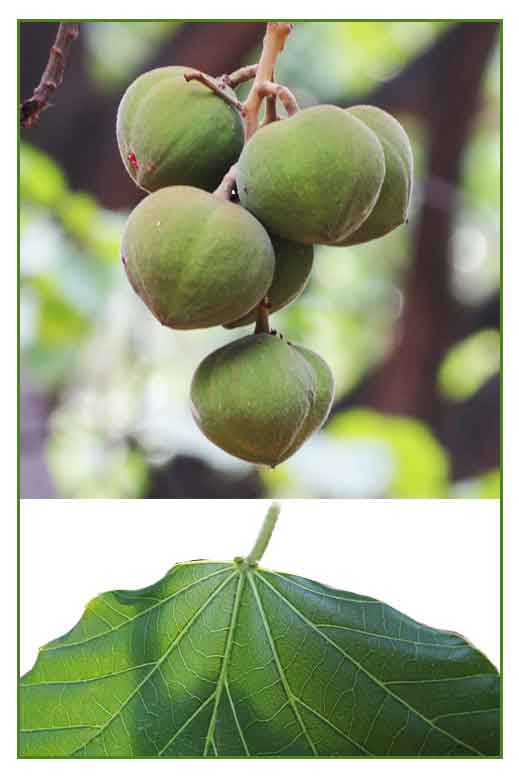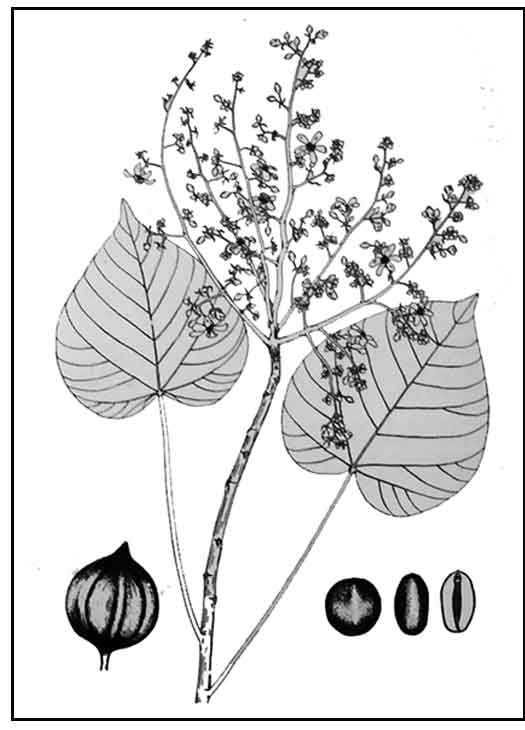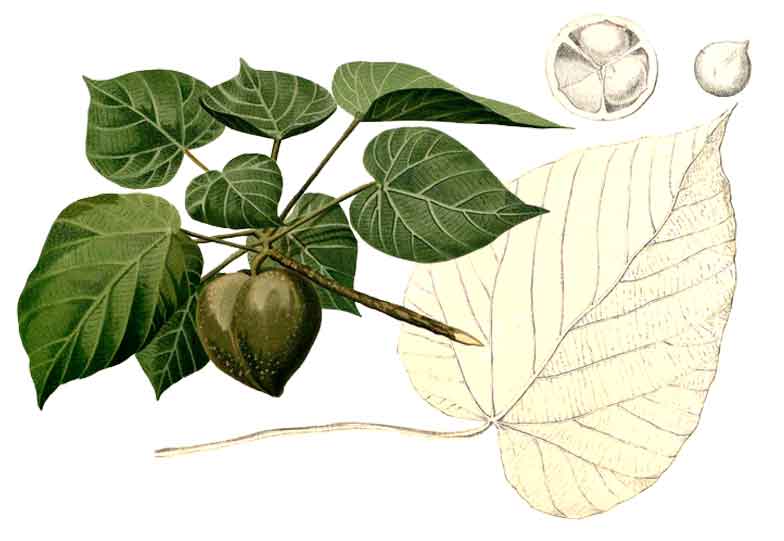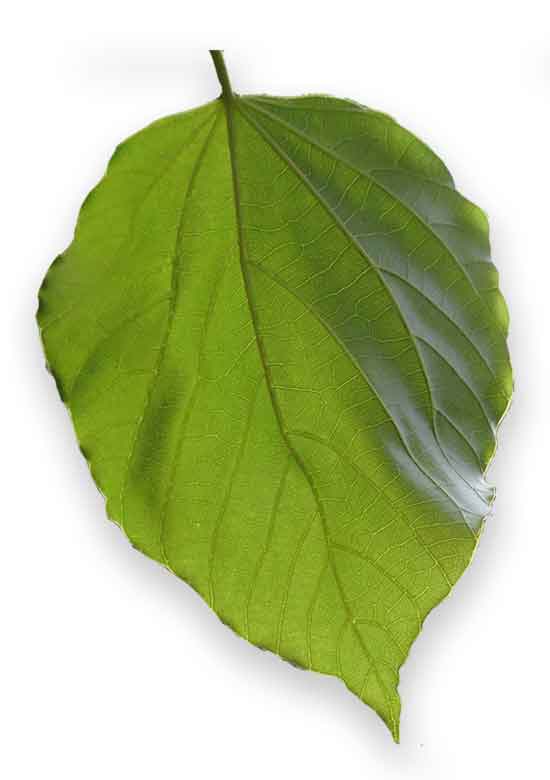
Family • Euphorbiaceae
Bagilumbang
Reutealis trisperma (Blanco) Airy Shaw
PHILIPPINE TUNG TREE
San zi tong
| Scientific names | Common names |
| Aleurites saponaria Blanco | Bagilumbang (Tag.) |
| Aleurites trisperma Blanco | Balukanag (Ilk., Bis., Tag.) |
| Camerium trispermum (Blanco) Kuntze | Banukalad (Tag.) |
| Reutealis trisperma (Blanco) Airy Shaw | Banunkalag (Tag.) |
| Balokanad (Tag.) | |
| Calumban (Tag.) | |
| Kalumbang (Tag.) | |
| Lumbang (Bik.) | |
| Lumbang-banukalad (Tag.) | |
| Kalumban (Tag.) | |
| Lumbang-gubat (Tag.) | |
| Lumbang-banukalad (Tag.) | |
| Lumbang tree (Engl.) | |
| Otaheite walnut (Engl.) | |
| Philippine tung tree (Engl.) | |
| Soft lumbang tree (Engl.) | |
| Sunan candlenut (Engl.) | |
| Lumbang is a common names shared by both Aleurites moluccana and A. trisperma. | |
| Reutealis trisperma is an accepted species. KEW: Plants of the World Online | |
| Other vernacular names |
| CHINESE: San sejin, San zi tong. |
| INDONESIAN: Kemiri sunan, Kemiri cina, Muncang cina, Minyak pakal. |
| SPANISH: Arbol de tung; Javillio. |
Botany • Trees to 15 m tall; trunk to 35 cm d.b.h. Petiole 14-15 cm; leaf blade ovate or ovate-cordate, 12-14 × 12-13 cm, abaxial surface with hair-tufts in many vein-axils, base usually deeply cordate with rounded lobes, sometimes rounded or obtuse on old trees, apex gland-tipped. Plants dioecious, sometimes monoecious. Male inflorescences flat-topped, with many cymelets. Male flowers: calyx cylindric, ca. 13 mm, 2- or 3-lobed, glabrous; petals 5, yellowish white, obovate, obovate-spatulate, or obovate-lanceolate, 8-16 × 3-5 mm; stamens 10-13, in 2 series; outer filaments free, inner ones connate at base. Female inflorescences flat-topped, racemose, or thyrsoid. Female flowers: ovary 3-celled, ovoid-globose-trigonous, densely appressed hairy; styles bifid. Capsule depressed globose to obtusely trigonous; pericarp 4-5 × 5-6.5 cm, longitudinally 3-angular, rugose, densely velutinous-pubescent. (Flora of China) Constituents Properties
Studies |
Updated April 2024 / March 2020 / April 2016
![]()
 |
PHOTOS / ILLUSTRATIONS |
| IMAGE SOURCE: Minor Products of Philippine Forests / Vol 2 / William Brown and Arthur Fisher / Figure 46 / Aleurites trisperma (Bagilumbang), The Source of Bagilumbang Oil / 1920 / Modifications by G. Stuart / Public Domain |
| OTHER IMAGE SOURCE: Reutealis trisperma fruit bunch (1) and leaf close up (2) / Forestowlet / 2014 / CC by SA: 4.0 / click on image to go to source page / Wikipedia |
| OTHER IMAGE SOURCE: Illustration: Reutealis trisperma / Flora de Filipinas / Franciso Manuel Blanco (OSA), 1880-1883 / Wikimedia Commons |
| OTHER IMAGE SOURCE: Reutealis trisperma leaf / Forestowlet / 2014 / CC0 / Image modified / Click on image or link to go to source page Wikimedia Commons |
| Additional
Sources and Suggested Readings (1) Bagilumbang or soft lumbang (Aleurites trisperma) oil / G. S. Jamieson and R. S. McKinney / JOURNAL OF THE AMERICAN OIL CHEMISTS' SOCIETY, Volume 12, Number 7, 146-148, DOI: 10.1007/BF02636731 / A Paper Presented at the 26th Annual Meeting of the American Oil Chemists' Society, at Memphis, Tenn., May 23–24, 1935. (2) Tung Flower Study: Doctor of tung flower leads you to the secrets of tung flower / 2010 Hakka Tung Blossom Festival (3) PRODUCTION OF UNUSUAL FATTY ACIDS IN PLANTS / David Hildebrand / Plant Lipid Biochemistry (4) Evaluation of radical scavenging activity of certain plant extracts using cell free assays / R.M. Samarth* and Vivek Krishna / Pharmacologyonline 1: 125-137 (2007) (5) Studies conducted at University of Matanzas on oil and gas recently published / Ol and Gas / Energy Business Journal (6) Lumbang Nut / Aleurites trisperma / Common Allergy Triggers in Georgia / Data from Betrock Information Systems (7) Reutealis trisperma / Synonyms / KEW: Plants of the World Online (8) Reutealis trisperma / Useful Tropical Plants (9) Reutealis Airy Shaw Euphobiaceae / CRC World Dictionary of Medicinal and Poisonous Plants: Common Names / Umberto Quattrocchi (10) The potential of Reutealis trisperma seed as a new non-edible source for biodiesel production / Holilah, Holilah; Didik, Prasetyoko; Titie, Oetami; Eka, Santosa; Yusuf, Zein; Hasliza, Bahruji; Hamzah, Fansuri; Ratna, Ediati; Juwari, Juwari / Biomass Conv. Bioref. (2015) 5:347-353 (11) OPTIMIZATION OF BIODIESEL PRODUCTION FROM Reutealis trisperma OIL USING NaOH AS CATALYST / Holilah (12) Biodiesel production and characterization from non-edible oil tree species Aleurites trisperma Blanco / K Rajesh Kumar, C Channarayapp, K Chandrika, Balakrishna Gowda et al / DOI: 10.1007/s13399-014-0152-4 (13) Reutealis trisperma / N.O. Aguilar & L.P.A. Oyen / Pl@ntUse (14) Factors affecting the bioconversion of Philippine tung seed by black soldier fly larvae for the production of protein and oil-rich biomass / Muhammad Yusuf Abduha,b,⁎, Mochamad Hirza Nadiaa, Syaripudina, Robert Manurunga, Ramadhani Eka Putraa / Journal of Asia-Pacific Entomology, 2018; 21: pp 836-842 / https://doi.org/10.1016/j.aspen.2018.06.007 (15) Biodiesel Production from Reutealis trisperma Oil Using Conventional and Ultrasonication through Esterification and Transesterification / Teuku Meurah Indra Riayatsyah, Razali Thaib, Arridina Susan Silitonga et al / Sustainability, 2021; 13(6): 3350 / DOI: 10.3390/su13063350 (16) Acute Toxicity of Extract of Sunan candlenut (Reutealis trisperma (Blanco) Airy Shaw) Seeds. / Nyi Mekar Saptarini, Resmi Mustarichie / Drug Invention Today, 2020; 14(5) / ISSN: 0975-7619 (17) Anti-HIV tigliane diterpenoids from Reutealis trisperma / Yan Lu, Ya-Si Huang, Chin-Ho Chen, Toshiyuki Akiyama, Dao-Feng Chen, Kuo-Hsiung Lee et al / Phytochemistry, 2020; Vol 174: 112360 / DOI: 10.1016/j.phytochem.2020.112360 (18) Gastrointestinal discomfort and hypotension in a patient with Reutealis trisperma seeds intoxication: A case report / Po-Min Chang MD, Yen-Yi Lee MD, Yen-Hung Wu MD / Medicine, 2021; 100(51): e28348 / DOI: 10.1097/MD.0000000000028348 (19) Suggested reading: Biofuels: growing renewables and restoring degraded land? (20) Evaluation of Kemiri Sunan (Reutealis trisperma Blanco) Seed oil nanoemulsion as insecticide against Planococcus minor (Hemiptera: Pseudococcidae) / Prabowo Heri, Damaiyani Janis / 1st Worksho on Environmental Science, Society, and Technology, 2018; Medan |
• |
DOI: It is not uncommon for links on studies/sources to change. Copying and pasting the information on the search window or using the DOI (if available) will often redirect to the new link page. (Citing and Using a (DOI) Digital Object Identifier) |
| List of Understudied Philippine Medicinal Plants |
| New plant names needed The compilation now numbers over 1,300 medicinal plants. While I believe there are hundreds more that can be added to the collection, they are becoming more difficult to find. If you have a plant to suggest for inclusion, native or introduced, please email the info: scientific name (most helpful), local plant name (if known), any known folkloric medicinal use, and, if possible, a photo. Your help will be greatly appreciated. |
• |
 |
• |


 Distribution
Distribution Uses
Uses
